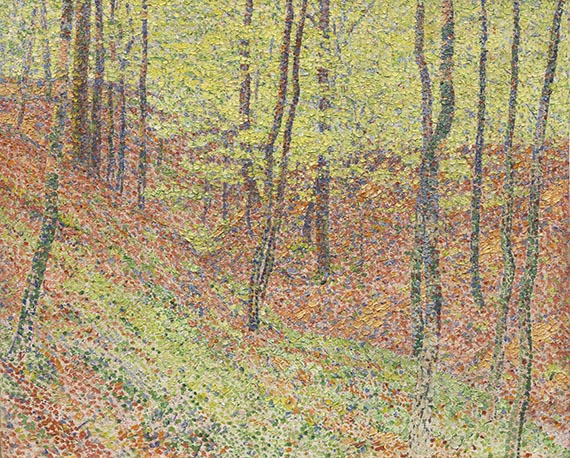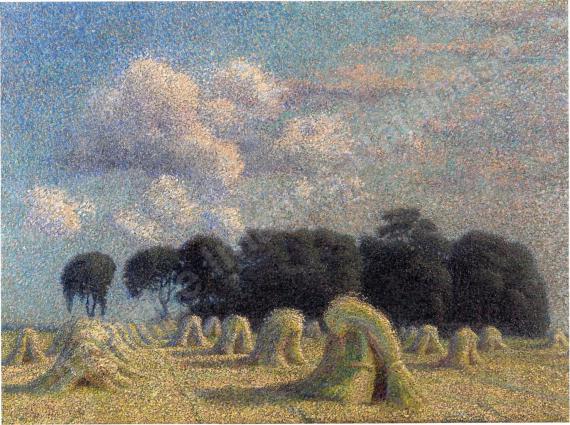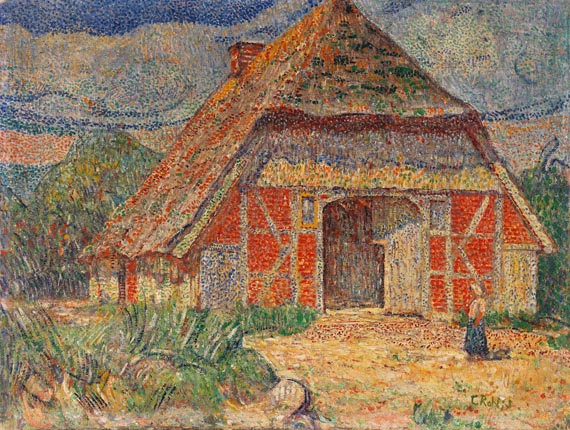Vente: 554 / Modern Art Day Sale 08 juin 2024 à Munich  Lot 123002001
Lot 123002001
 Lot 123002001
Lot 123002001
123002001
Christian Rohlfs
Wald, Um 1903.
Oil on canvas
Estimation: € 70,000 / $ 74,900
Les informations sur la commission d´achat, les taxes et le droit de suite sont disponibles quatre semaines avant la vente.
Wald. Um 1903.
Oil on canvas.
75 x 90 cm (29.5 x 35.4 in).
Inscribed with several personal dedications from 1943 by the owners on the reverse of the canvas and the stretcher.
• Spectacular rediscovery of a Rohlfs painting.
• Obtained directly from the artist, ever since in family possession.
• Early, wonderfully dense, pointillist work by Christian Rohlfs.
• Vivid testimony to the artist's unbroken urge to explore new paths.
• Works from this short creative period from 1902 to 1904 and of this quality are extremely rare on the international auction market.
Accompanied by a written confirmation of authenticity issued by the Christian Rohlfs Archive at Osthaus Museum, Hagen, dated October 5, 2023 (height erroneously indicated as 45 cm). The work was included in the archive under the number CRA 264/23.
PROVENANCE: Otto Stahl Collection, Weimar (with a barely visible stamp on the reverse of the stretcher, presumably obtained from the artist, ever since family-owned).
Private collection Baden-Württemberg.
Oil on canvas.
75 x 90 cm (29.5 x 35.4 in).
Inscribed with several personal dedications from 1943 by the owners on the reverse of the canvas and the stretcher.
• Spectacular rediscovery of a Rohlfs painting.
• Obtained directly from the artist, ever since in family possession.
• Early, wonderfully dense, pointillist work by Christian Rohlfs.
• Vivid testimony to the artist's unbroken urge to explore new paths.
• Works from this short creative period from 1902 to 1904 and of this quality are extremely rare on the international auction market.
Accompanied by a written confirmation of authenticity issued by the Christian Rohlfs Archive at Osthaus Museum, Hagen, dated October 5, 2023 (height erroneously indicated as 45 cm). The work was included in the archive under the number CRA 264/23.
PROVENANCE: Otto Stahl Collection, Weimar (with a barely visible stamp on the reverse of the stretcher, presumably obtained from the artist, ever since family-owned).
Private collection Baden-Württemberg.
With an oeuvre that covers well over six decades, Christian Rohlfs is one of the most important protagonists of Modern Art in Germany. Today, he is primarily esteemed for his late expressionist work, while his experimental phase around the turn of the century is also considered a crucial period in his artistic development. A period characterized by a high degree of innovativeness, it laid the foundation for a new turn his art would take in the following decades. As early as around the end of the 19th century, Christian Rohlfs' gradually liberated his art from Realism and Naturalism and took first steps towards Neo-Impressionism, demonstrating his strong urge to move on. From a historical point of view, this change was very much in line with the overall atmosphere in society at a time of a new beginning after his time at the academy in Weimar. His move from Weimar to Hagen in 1901 was also decisive for his quest for new forms of expression. Karl Ernst Osthaus, who opened the Folkwang Museum in 1902, brought him in contact with the latest contemporary tendencies.
This resulted in a small group of pointillist paintings made between 1902 and 1904, including the present "Wald" (Forest) from around 1903. As it had already been the case in earlier phases, Christian Rohlfs once more found inspiration in French models. However, he remained more committed to color as material and the subject of the painting than it could be said of the Parisian avant-garde. By densely placing the dots of color, he created a view of a forest on the canvas that guides the viewer's eye to the very heart of the forest without horizon or treetops. Although the motif can be clearly recognized, he put the focus on the intense play of colors between vibrant green leaves and red and brown nuances of the ground and the trunks, eventually finding balance between the clarity of the motif and the shimmering colors. In terms of motif, Rohlfs still draws on real views from Weimar, where he continued to spend his summers. However, the Ruhr region and and the Volmetal valley near Hagen also served as models for his new and experimental landscapes.
The pointillist works from this period testify to how Rohlfs continuously put his artistic convictions to the test, even at the advanced age of over 50. "His oeuvre demonstrates that he was a painter with a high receptive capacity and an astonishing versatility, always ready to relinquish what he had painstakingly acquired if he was fascinated with new ideas," says Paul Vogt, author of the catalogue raisonné of the paintings, describing the stylistic development with a view to the artist's oeuvre as a whole, which underwent another radical stylistic change in the last decades of his life (Paul Vogt, Christian Rohlfs. Oeuvre-Katalog der Gemälde, Recklinghausen 1978, p. 12). Since the painting "Wald" became part of a private collection more than half a century ago, it is now presented to the public again for the first time. Without question, this is a spectacular rediscovery of a Christian Rohlfs painting and at the same time a sign of the revived appreciation of this important phase in the artist's oeuvre on his way to the groundbreaking stylistic endeavors in Expressionism. [AR]
This resulted in a small group of pointillist paintings made between 1902 and 1904, including the present "Wald" (Forest) from around 1903. As it had already been the case in earlier phases, Christian Rohlfs once more found inspiration in French models. However, he remained more committed to color as material and the subject of the painting than it could be said of the Parisian avant-garde. By densely placing the dots of color, he created a view of a forest on the canvas that guides the viewer's eye to the very heart of the forest without horizon or treetops. Although the motif can be clearly recognized, he put the focus on the intense play of colors between vibrant green leaves and red and brown nuances of the ground and the trunks, eventually finding balance between the clarity of the motif and the shimmering colors. In terms of motif, Rohlfs still draws on real views from Weimar, where he continued to spend his summers. However, the Ruhr region and and the Volmetal valley near Hagen also served as models for his new and experimental landscapes.
The pointillist works from this period testify to how Rohlfs continuously put his artistic convictions to the test, even at the advanced age of over 50. "His oeuvre demonstrates that he was a painter with a high receptive capacity and an astonishing versatility, always ready to relinquish what he had painstakingly acquired if he was fascinated with new ideas," says Paul Vogt, author of the catalogue raisonné of the paintings, describing the stylistic development with a view to the artist's oeuvre as a whole, which underwent another radical stylistic change in the last decades of his life (Paul Vogt, Christian Rohlfs. Oeuvre-Katalog der Gemälde, Recklinghausen 1978, p. 12). Since the painting "Wald" became part of a private collection more than half a century ago, it is now presented to the public again for the first time. Without question, this is a spectacular rediscovery of a Christian Rohlfs painting and at the same time a sign of the revived appreciation of this important phase in the artist's oeuvre on his way to the groundbreaking stylistic endeavors in Expressionism. [AR]
123002001
Christian Rohlfs
Wald, Um 1903.
Oil on canvas
Estimation: € 70,000 / $ 74,900
Les informations sur la commission d´achat, les taxes et le droit de suite sont disponibles quatre semaines avant la vente.






